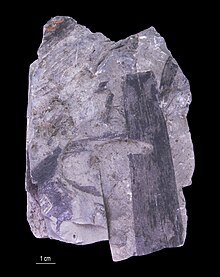
The Carboniferous is a geologic period and system of the Paleozoic era that spans 60 million years from the end of the Devonian Period 358.86 Ma to the beginning of the Permian Period, 298.9 Ma. It is the fifth and penultimate period of the Paleozoic era and the fifth period of the Phanerozoic eon. In North America, the Carboniferous is often treated as two separate geological periods, the earlier Mississippian and the later Pennsylvanian.
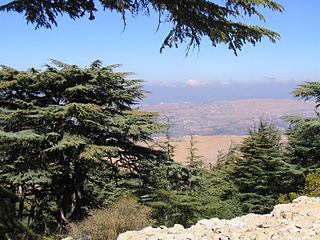
Cedrus, with the common English name cedar, is a genus of coniferous trees in the plant family Pinaceae. They are native to the mountains of the western Himalayas and the Mediterranean region, occurring at altitudes of 1,500–3,200 m (4,900–10,500 ft) in the Himalayas and 1,000–2,200 m (3,300–7,200 ft) in the Mediterranean.

Lycopodiopsida is a class of vascular plants also known as lycopsids, lycopods, or lycophytes. Members of the class are also called clubmosses, firmosses, spikemosses and quillworts. They have dichotomously branching stems bearing simple leaves called microphylls and reproduce by means of spores borne in sporangia on the sides of the stems at the bases of the leaves. Although living species are small, during the Carboniferous, extinct tree-like forms (Lepidodendrales) formed huge forests that dominated the landscape and contributed to coal deposits.

Conifers are a group of cone-bearing seed plants, a subset of gymnosperms. Scientifically, they make up the division Pinophyta, also known as Coniferophyta or Coniferae. The division contains a single extant class, Pinopsida. All extant conifers are perennial woody plants with secondary growth. The great majority are trees, though a few are shrubs. Examples include cedars, Douglas-firs, cypresses, firs, junipers, kauri, larches, pines, hemlocks, redwoods, spruces, and yews. As of 2002, Pinophyta contained seven families, 60 to 65 genera, and more than 600 living species.

Larches are deciduous conifers in the genus Larix, of the family Pinaceae. Growing from 20 to 50 metres tall, they are native to the cooler regions of the northern hemisphere, where they are found in lowland forests in the high latitudes, and high in mountains further south. Larches are among the dominant plants in the boreal forests of Siberia and Canada. Although they are conifers, larches are deciduous trees that lose their needles in the autumn.

Firs are evergreen coniferous trees belonging to the genus Abies in the family Pinaceae. There are approximately 48–65 extant species, found on mountains throughout much of North and Central America, Eurasia, and North Africa. The genus is most closely related to Keteleeria, a small genus confined to eastern Asia.

Cycads are seed plants that typically have a stout and woody (ligneous) trunk with a crown of large, hard, stiff, evergreen and (usually) pinnate leaves. The species are dioecious, that is, individual plants of a species are either male or female. Cycads vary in size from having trunks only a few centimeters to several meters tall. They typically grow slowly and have long lifespans. Because of their superficial resemblance to palms or ferns, they are sometimes mistaken for them, but they are not closely related to either group. Cycads are gymnosperms (naked-seeded), meaning their unfertilized seeds are open to the air to be directly fertilized by pollination, as contrasted with angiosperms, which have enclosed seeds with more complex fertilization arrangements. Cycads have very specialized pollinators, usually a specific species of beetle. Both male and female cycads bear cones (strobili), somewhat similar to conifer cones.

Araucariaceae is a family of conifers with three living genera, Araucaria, Agathis, and Wollemia. While the family's native distribution is now largely confined to the Southern Hemisphere, except for a few species of Agathis in Malesia, it was formerly widespread in the Northern Hemisphere during the Jurassic and Cretaceous periods.

The gymnosperms are a group of woody, perennial seed-producing plants, typically lacking the protective outer covering which surrounds the seeds in flowering plants, that include conifers, cycads, Ginkgo, and gnetophytes, forming the clade Gymnospermae The term gymnosperm comes from the composite word in Greek: γυμνόσπερμος, and literally means 'naked seeds'. The name is based on the unenclosed condition of their seeds. The non-encased condition of their seeds contrasts with the seeds and ovules of flowering plants (angiosperms), which are enclosed within an ovary. Gymnosperm seeds develop either on the surface of scales or leaves, which are often modified to form cones, or on their own as in yew, Torreya, and Ginkgo.

The Pinaceae, or pine family, are conifer trees or shrubs, including many of the well-known conifers of commercial importance such as cedars, firs, hemlocks, piñons, larches, pines and spruces. The family is included in the order Pinales, formerly known as Coniferales. Pinaceae have distinctive cones with woody scales bearing typically two ovules, and are supported as monophyletic by both morphological trait and genetic analysis. They are the largest extant conifer family in species diversity, with between 220 and 250 species in 11 genera, and the second-largest in geographical range, found in most of the Northern Hemisphere, with the majority of the species in temperate climates, but ranging from subarctic to tropical. The family often forms the dominant component of boreal, coastal, and montane forests. One species, Pinus merkusii, grows just south of the equator in Southeast Asia. Major centres of diversity are found in the mountains of southwest China, Mexico, central Japan, and California.
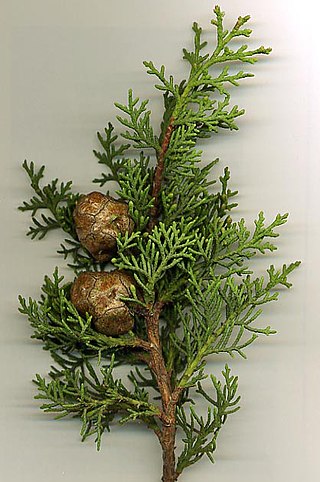
Cupressaceae or the cypress family is a family of conifers. The family includes 27–30 genera, which include the junipers and redwoods, with about 130–140 species in total. They are monoecious, subdioecious or (rarely) dioecious trees and shrubs up to 116 m (381 ft) tall. The bark of mature trees is commonly orange- to red-brown and of stringy texture, often flaking or peeling in vertical strips, but smooth, scaly or hard and square-cracked in some species. The family reached its peak of diversity during the mesozoic era.

Tsuga is a genus of conifers in the subfamily Abietoideae of Pinaceae, the pine family. The English-language common name "hemlock" arose from a perceived similarity in the smell of its crushed foliage to that of the unrelated plant hemlock. Unlike the latter, Tsuga species are not poisonous.

A conifer cone, or in formal botanical usage a strobilus, pl.: strobili, is a seed-bearing organ on gymnosperm plants, especially in conifers and cycads. They are usually woody and variously conic, cylindrical, ovoid, to globular, and have scales and bracts arranged around a central axis, but can be fleshy and berry-like. The cone of Pinophyta contains the reproductive structures. The woody cone is the female cone, which produces seeds. The male cone, which produces pollen, is usually ephemeral and much less conspicuous even at full maturity. The name "cone" derives from Greek konos, which also gave name to the geometric cone. The individual plates of a cone are known as scales. In conifers where the cone develops over more than one year, the first year's growth of a seed scale on the cone, showing up as a protuberance at the end of the two-year-old scale, is called an umbo, while the second year's growth is called the apophysis.

Lepidodendron is an extinct genus of primitive lycopodian vascular plants belonging the order Lepidodendrales. It is well preserved and common in the fossil record. Like other Lepidodendrales, species of Lepidodendron grew as large-tree-like plants in wetland coal forest environments. They sometimes reached heights of 50 metres, and the trunks were often over 1 m in diameter. They are often known as "scale trees", due to their bark having been covered in diamond shaped leaf-bases, from which leaves grew during earlier stages of growth. However, they are correctly defined as arborescent lycophytes. They thrived during the Carboniferous Period, and persisted until the end of the Permian around 252 million years ago. Sometimes erroneously called "giant club mosses", the genus was actually more closely related to modern quillworts than to modern club mosses. In the form classification system used in paleobotany, Lepidodendron is both used for the whole plant as well as specifically the stems and leaves.
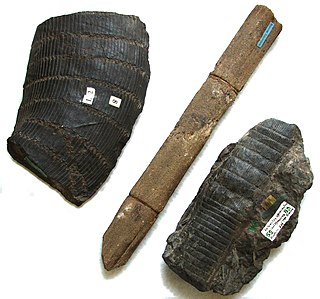
Calamites is a genus of extinct arborescent (tree-like) horsetails to which the modern horsetails are closely related. Unlike their herbaceous modern cousins, these plants were medium-sized trees, growing to heights of 30–50 meters. They were components of the understories of coal swamps of the Carboniferous Period.
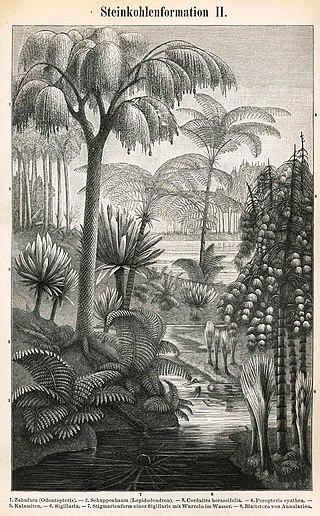
Coal forests were the vast swathes of freshwater swamp and riparian forests that covered much of the lands on Earth's tropical regions during the late Carboniferous (Pennsylvanian) and Permian periods. As plant matter from these wetland forests decayed, enormous deposits of peat accumulated, which later became buried and converted into coal over the subsequent geologic eras.

Abies delavayi, the Delavay's silver-fir or Delavay's fir, is a species of fir, native to Yunnan in southwest China and adjoining border areas in southeastern Tibet, far northeastern India, northern Myanmar, and far northwestern Vietnam. It is a high altitude mountain tree, growing at elevations of 3,000–4,000 m, often occupying the tree line.
This article attempts to place key plant innovations in a geological context. It concerns itself only with novel adaptations and events that had a major ecological significance, not those that are of solely anthropological interest. The timeline displays a graphical representation of the adaptations; the text attempts to explain the nature and robustness of the evidence.

A seed plant or spermatophyte, also known as a phanerogam or a phaenogam, is any plant that produces seeds. It is a category of embryophyte that includes most of the familiar land plants, including the flowering plants and the gymnosperms, but not ferns, mosses, or algae.

Utrechtiaceae is an extinct family of trees related to modern conifers. This family dates back to the late Carboniferous and Early Permian.
